Palmyra: Vintage Cars and Desert Highways
Today's vintage car looks identical to my birthday ride. The owner tells me this is a '51 Pontiac, and with steaming vinyl seats and lack of air, it feels like '51 inside.
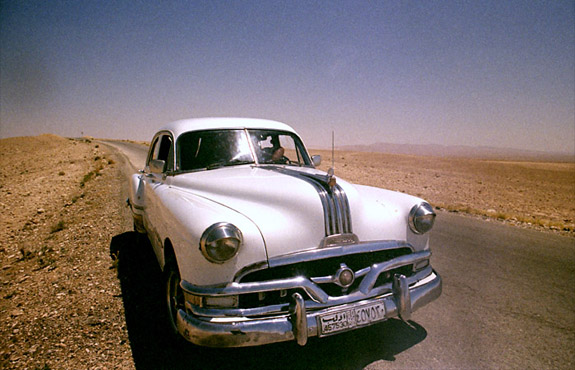 |
| '51 Pontiac on the Desert Highway |
Grant and I meet at 9AM sharp, and realize Runa is still in bed. When he joins us at 9:30, we find a different driver than expected. Just as nice, slightly different car, but the problem is he speaks no English at all. Runa has studied Arabic, but as most of it is formal written Arabic and spoken Egyptian dialect, the interpretation process is imperfect. Runa carries on attempting Arabic conversation while Grant and I do crosswords in the backseat. It's so freaking hot on the vinyl seats.
We stop at a tiny village with a couple remaining beehive houses no longer in use. I had been eager to go on a true tour of a traditional beehive house village, but without anyone to join me I couldn't afford it. At this village, the minute we climb out of the car we see a stream of children coming from afar. We poke around a bit, looking up startled when the children set upon us clamoring feloush, feloush (money). Creeped out, we decide we're done with beehives.
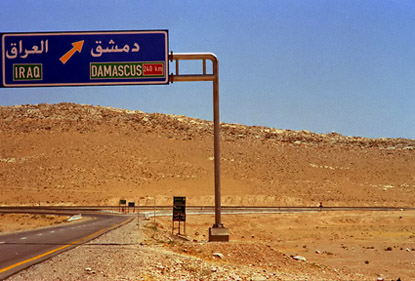 Almost there... |
Compromise appears. After hours of desert, we see a highway sign for Iraq, and our driver happily obliges us in a photo shoot. There is really no one for miles...we have not seen another car since we entered the desert. Curiosity mollified for the time being (although we were really no closer to Iraq than to Damascus), we continue on to Palmyra.
Since we weren't going to be taking public transportation, we enjoyed the chance to sleep in—thus the late start to our day. Unfortunately, Palmyra is further than we expected, so when we arrive it's 12:30, boiling hot, and we are starving. The driver tries multiple times to dissuade us from eating, but we can't understand why.
We stop in a place called Pancake House, which sounds ideal just about now. The pancakes are either savory or sweet, very thick and spongy. I have a pancake stuffed with lamb while Grant, convinced he should not eat meat while traveling, opts for veggies. The pancakes are huge and cost a mere 300 SYP with two glasses of fresh orange juice. Runa has an omelet, which arrives doused in tomato sauce.
While we snarf our absolutely delicious meals, a loud group of travelers enters Pancake House. We secretly place bets on where everyone's from—Grant sees a large rough-looking dude and insists he's American, while I sagely point out his sleeveless shirt as indication he isn't. I win. The group is on a sort of guided-backpacking tour through the Middle East. They stay in the same hotels we do, eat in cheap restaurants of their choosing, but they have a guide and driver who are pushing them through 5 countries in 5 weeks.
When we rejoin our driver, we discover why he tried to prevent us from eating—the Temple of Bel closes from 1:00-4:00. Because we still don't understand at first, he drives us there so we can see for ourselves. Languages are fun! Now we have over two hours to wander the rest of the ruins before returning.
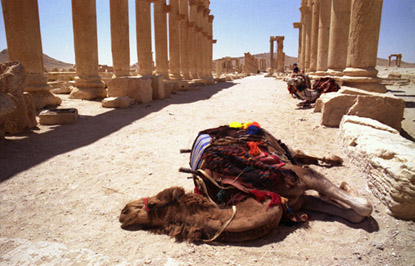 |
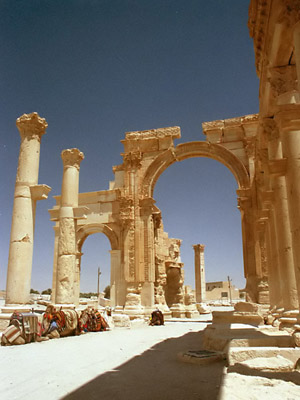 |
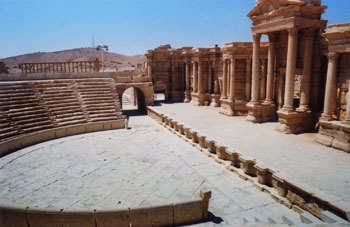 |
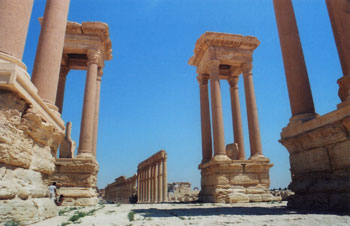 |
| The tetrapylon |
After getting our fill of Roman columns, we return to the Pontiac in relief. It's hot inside as well of course, but it's still nice to be driven around. We drive to the Arab castle Ibn Maan, located on a high hill with excellent views of Palmyra. If you can't handle walking there in the heat, taxis in town are more than happy to overcharge. Another bonus to already having transport.
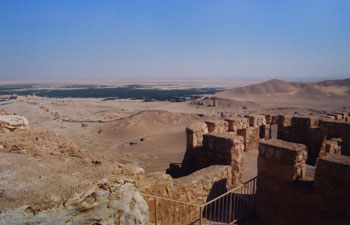 |
| View from Ibn Maan |
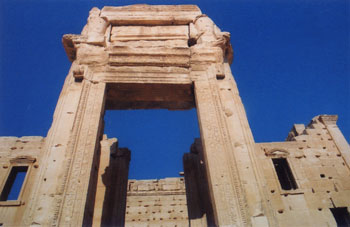 |
| The Temple of Bel |
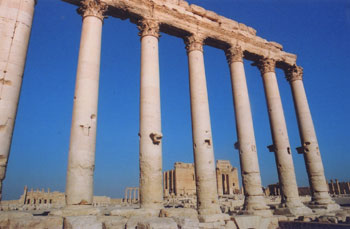 |
| The Temple of Bel |
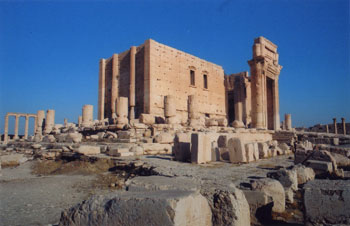 |
| The Temple of Bel |
The Temple is spectacular. The complex is huge, with a few standing remains of a colonnade and enormous chunks of fallen columns strewn about. The Temple itself is in excellent condition, with intricately-carved doorways and stones scattered near the entrance. We were the only visitors at this time of day, which added to the pleasure of meandering through the complex.
The heat messes with our minds, so we're still unclear on how long it takes to return to the sunset portion of the trip. We stop back in Pancake House for some fresh juice—our driver has given up on trying to direct us. Despite the proliferation of cheap fresh juice stands everywhere else in Syria, here the only thing available is orange juice at relatively steep prices. Back on the Pontiac, we realize we are way too late to see the sunset at the other ruined castle. We hope to at least see a beautiful desert sunset, but it happens while we're driving through a small town. We pass our intended spot well after dark.
Runa asks us what we think was the best part of the day.
"The Temple of Bel," I say.
"The Temple," Grant agrees.
"The omelet," Runa declares with conviction.